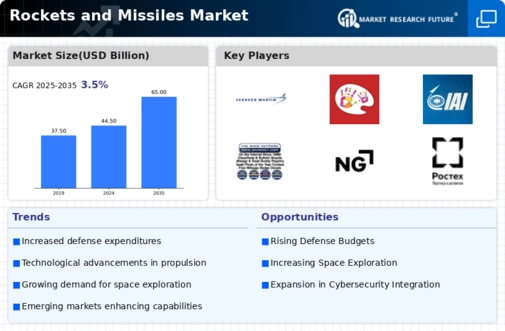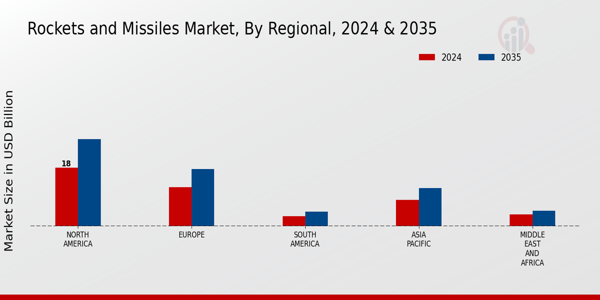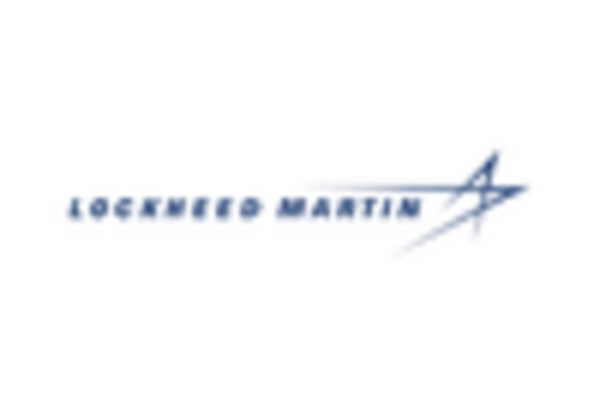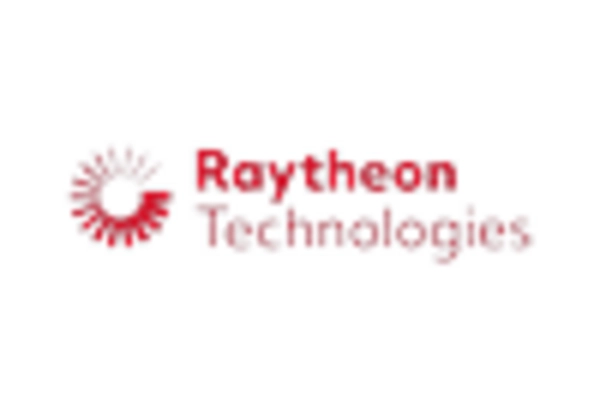-
MARKET FACTOR ANALYSIS
-
\r\n5.1. Value chain Analysis
-
\r\n5.2. Porter's
-
Five Forces Analysis
-
\r\n5.2.1. Bargaining Power of Suppliers
-
\r\n5.2.2.
-
Bargaining Power of Buyers
-
\r\n5.2.3. Threat of New Entrants
-
\r\n5.2.4.
-
Threat of Substitutes
-
\r\n5.2.5. Intensity of Rivalry
-
\r\n5.3. COVID-19
-
Impact Analysis
-
\r\n5.3.1. Market Impact Analysis
-
\r\n5.3.2. Regional
-
Impact
-
\r\n5.3.3. Opportunity and Threat Analysis
-
\r\n6. ROCKETS AND
-
MISSILES MARKET, BY APPLICATION (USD BILLION)
-
\r\n6.1. Defense
-
\r\n6.2.
-
Space Exploration
-
\r\n6.3. Commercial Launch Services
-
\r\n6.4. Scientific
-
Research
-
\r\n7. ROCKETS AND MISSILES MARKET, BY TYPE (USD BILLION)
-
\r\n7.1.
-
Ballistic Missiles
-
\r\n7.2. Cruise Missiles
-
\r\n7.3. Space Launch Vehicles
-
\r\n7.4.
-
Tactical Missiles
-
\r\n8. ROCKETS AND MISSILES MARKET, BY LAUNCH MODE (USD
-
BILLION)
-
\r\n8.1. Vertical Launch
-
\r\n8.2. Horizontal Launch
-
\r\n8.3.
-
Suborbital Launch
-
\r\n9. ROCKETS AND MISSILES MARKET, BY TECHNOLOGY (USD BILLION)
-
\r\n9.1.
-
Solid Propellant
-
\r\n9.2. Liquid Propellant
-
\r\n9.3. Hybrid Propellant
-
\r\n10.
-
ROCKETS AND MISSILES MARKET, BY REGIONAL (USD BILLION)
-
\r\n10.1. North America
-
\r\n10.1.1.
-
US
-
\r\n10.1.2. Canada
-
\r\n10.2. Europe
-
\r\n10.2.1. Germany
-
\r\n10.2.2.
-
UK
-
\r\n10.2.3. France
-
\r\n10.2.4. Russia
-
\r\n10.2.5. Italy
-
\r\n10.2.6.
-
Spain
-
\r\n10.2.7. Rest of Europe
-
\r\n10.3. APAC
-
\r\n10.3.1. China
-
\r\n10.3.2.
-
India
-
\r\n10.3.3. Japan
-
\r\n10.3.4. South Korea
-
\r\n10.3.5. Malaysia
-
\r\n10.3.6.
-
Thailand
-
\r\n10.3.7. Indonesia
-
\r\n10.3.8. Rest of APAC
-
\r\n10.4.
-
South America
-
\r\n10.4.1. Brazil
-
\r\n10.4.2. Mexico
-
\r\n10.4.3.
-
Argentina
-
\r\n10.4.4. Rest of South America
-
\r\n10.5. MEA
-
\r\n10.5.1.
-
GCC Countries
-
\r\n10.5.2. South Africa
-
\r\n10.5.3. Rest of MEA
-
\r\n11.
-
COMPETITIVE LANDSCAPE
-
\r\n11.1. Overview
-
\r\n11.2. Competitive Analysis
-
\r\n11.3.
-
Market share Analysis
-
\r\n11.4. Major Growth Strategy in the Rockets and Missiles
-
Market
-
\r\n11.5. Competitive Benchmarking
-
\r\n11.6. Leading Players
-
in Terms of Number of Developments in the Rockets and Missiles Market
-
\r\n11.7.
-
Key developments and growth strategies
-
\r\n11.7.1. New Product Launch/Service
-
Deployment
-
\r\n11.7.2. Merger & Acquisitions
-
\r\n11.7.3. Joint Ventures
-
\r\n11.8.
-
Major Players Financial Matrix
-
\r\n11.8.1. Sales and Operating Income
-
\r\n11.8.2.
-
Major Players R&D Expenditure. 2023
-
\r\n12. COMPANY PROFILES
-
\r\n12.1.
-
Rafael Advanced Defense Systems
-
\r\n12.1.1. Financial Overview
-
\r\n12.1.2.
-
Products Offered
-
\r\n12.1.3. Key Developments
-
\r\n12.1.4. SWOT Analysis
-
\r\n12.1.5.
-
Key Strategies
-
\r\n12.2. Airbus
-
\r\n12.2.1. Financial Overview
-
\r\n12.2.2.
-
Products Offered
-
\r\n12.2.3. Key Developments
-
\r\n12.2.4. SWOT Analysis
-
\r\n12.2.5.
-
Key Strategies
-
\r\n12.3. Elbit Systems
-
\r\n12.3.1. Financial Overview
-
\r\n12.3.2.
-
Products Offered
-
\r\n12.3.3. Key Developments
-
\r\n12.3.4. SWOT Analysis
-
\r\n12.3.5.
-
Key Strategies
-
\r\n12.4. Northrop Grumman
-
\r\n12.4.1. Financial Overview
-
\r\n12.4.2.
-
Products Offered
-
\r\n12.4.3. Key Developments
-
\r\n12.4.4. SWOT Analysis
-
\r\n12.4.5.
-
Key Strategies
-
\r\n12.5. Leonardo
-
\r\n12.5.1. Financial Overview
-
\r\n12.5.2.
-
Products Offered
-
\r\n12.5.3. Key Developments
-
\r\n12.5.4. SWOT Analysis
-
\r\n12.5.5.
-
Key Strategies
-
\r\n12.6. RollsRoyce
-
\r\n12.6.1. Financial Overview
-
\r\n12.6.2.
-
Products Offered
-
\r\n12.6.3. Key Developments
-
\r\n12.6.4. SWOT Analysis
-
\r\n12.6.5.
-
Key Strategies
-
\r\n12.7. Lockheed Martin
-
\r\n12.7.1. Financial Overview
-
\r\n12.7.2.
-
Products Offered
-
\r\n12.7.3. Key Developments
-
\r\n12.7.4. SWOT Analysis
-
\r\n12.7.5.
-
Key Strategies
-
\r\n12.8. Boeing
-
\r\n12.8.1. Financial Overview
-
\r\n12.8.2.
-
Products Offered
-
\r\n12.8.3. Key Developments
-
\r\n12.8.4. SWOT Analysis
-
\r\n12.8.5.
-
Key Strategies
-
\r\n12.9. Kratos Defense and Security Solutions
-
\r\n12.9.1.
-
Financial Overview
-
\r\n12.9.2. Products Offered
-
\r\n12.9.3. Key Developments
-
\r\n12.9.4.
-
SWOT Analysis
-
\r\n12.9.5. Key Strategies
-
\r\n12.10. MDA
-
\r\n12.10.1.
-
Financial Overview
-
\r\n12.10.2. Products Offered
-
\r\n12.10.3. Key Developments
-
\r\n12.10.4.
-
SWOT Analysis
-
\r\n12.10.5. Key Strategies
-
\r\n12.11. Raytheon Technologies
-
\r\n12.11.1.
-
Financial Overview
-
\r\n12.11.2. Products Offered
-
\r\n12.11.3. Key Developments
-
\r\n12.11.4.
-
SWOT Analysis
-
\r\n12.11.5. Key Strategies
-
\r\n12.12. Saab
-
\r\n12.12.1.
-
Financial Overview
-
\r\n12.12.2. Products Offered
-
\r\n12.12.3. Key Developments
-
\r\n12.12.4.
-
SWOT Analysis
-
\r\n12.12.5. Key Strategies
-
\r\n12.13. Thales Group
-
\r\n12.13.1.
-
Financial Overview
-
\r\n12.13.2. Products Offered
-
\r\n12.13.3. Key Developments
-
\r\n12.13.4.
-
SWOT Analysis
-
\r\n12.13.5. Key Strategies
-
\r\n12.14. Huntington Ingalls
-
Industries
-
\r\n12.14.1. Financial Overview
-
\r\n12.14.2. Products Offered
-
\r\n12.14.3.
-
Key Developments
-
\r\n12.14.4. SWOT Analysis
-
\r\n12.14.5. Key Strategies
-
\r\n12.15.
-
General Dynamics
-
\r\n12.15.1. Financial Overview
-
\r\n12.15.2. Products
-
Offered
-
\r\n12.15.3. Key Developments
-
\r\n12.15.4. SWOT Analysis
-
\r\n12.15.5.
-
Key Strategies
-
\r\n13. APPENDIX
-
\r\n13.1. References
-
\r\n13.2.
-
Related Reports
-
\r\nLIST OF TABLES
-
\r\nTABLE 1. LIST OF ASSUMPTIONS
-
\r\nTABLE
-
NORTH AMERICA ROCKETS AND MISSILES MARKET SIZE ESTIMATES & FORECAST, BY APPLICATION,
-
\r\nTABLE 3. NORTH AMERICA ROCKETS AND MISSILES MARKET
-
SIZE ESTIMATES & FORECAST, BY TYPE, 2019-2035 (USD BILLIONS)
-
\r\nTABLE
-
NORTH AMERICA ROCKETS AND MISSILES MARKET SIZE ESTIMATES & FORECAST, BY LAUNCH
-
MODE, 2019-2035 (USD BILLIONS)
-
\r\nTABLE 5. NORTH AMERICA ROCKETS AND MISSILES
-
MARKET SIZE ESTIMATES & FORECAST, BY TECHNOLOGY, 2019-2035 (USD BILLIONS)
-
\r\nTABLE
-
NORTH AMERICA ROCKETS AND MISSILES MARKET SIZE ESTIMATES & FORECAST, BY REGIONAL,
-
\r\nTABLE 7. US ROCKETS AND MISSILES MARKET SIZE
-
ESTIMATES & FORECAST, BY APPLICATION, 2019-2035 (USD BILLIONS)
-
\r\nTABLE
-
US ROCKETS AND MISSILES MARKET SIZE ESTIMATES & FORECAST, BY TYPE, 2019-2035
-
(USD BILLIONS)
-
\r\nTABLE 9. US ROCKETS AND MISSILES MARKET SIZE ESTIMATES
-
& FORECAST, BY LAUNCH MODE, 2019-2035 (USD BILLIONS)
-
\r\nTABLE 10. US
-
ROCKETS AND MISSILES MARKET SIZE ESTIMATES & FORECAST, BY TECHNOLOGY, 2019-2035
-
(USD BILLIONS)
-
\r\nTABLE 11. US ROCKETS AND MISSILES MARKET SIZE ESTIMATES
-
& FORECAST, BY REGIONAL, 2019-2035 (USD BILLIONS)
-
\r\nTABLE 12. CANADA
-
ROCKETS AND MISSILES MARKET SIZE ESTIMATES & FORECAST, BY APPLICATION, 2019-2035
-
(USD BILLIONS)
-
\r\nTABLE 13. CANADA ROCKETS AND MISSILES MARKET SIZE ESTIMATES
-
& FORECAST, BY TYPE, 2019-2035 (USD BILLIONS)
-
\r\nTABLE 14. CANADA ROCKETS
-
AND MISSILES MARKET SIZE ESTIMATES & FORECAST, BY LAUNCH MODE, 2019-2035 (USD
-
BILLIONS)
-
\r\nTABLE 15. CANADA ROCKETS AND MISSILES MARKET SIZE ESTIMATES
-
& FORECAST, BY TECHNOLOGY, 2019-2035 (USD BILLIONS)
-
\r\nTABLE 16. CANADA
-
ROCKETS AND MISSILES MARKET SIZE ESTIMATES & FORECAST, BY REGIONAL, 2019-2035
-
(USD BILLIONS)
-
\r\nTABLE 17. EUROPE ROCKETS AND MISSILES MARKET SIZE ESTIMATES
-
& FORECAST, BY APPLICATION, 2019-2035 (USD BILLIONS)
-
\r\nTABLE 18. EUROPE
-
ROCKETS AND MISSILES MARKET SIZE ESTIMATES & FORECAST, BY TYPE, 2019-2035 (USD
-
BILLIONS)
-
\r\nTABLE 19. EUROPE ROCKETS AND MISSILES MARKET SIZE ESTIMATES
-
& FORECAST, BY LAUNCH MODE, 2019-2035 (USD BILLIONS)
-
\r\nTABLE 20. EUROPE
-
ROCKETS AND MISSILES MARKET SIZE ESTIMATES & FORECAST, BY TECHNOLOGY, 2019-2035
-
(USD BILLIONS)
-
\r\nTABLE 21. EUROPE ROCKETS AND MISSILES MARKET SIZE ESTIMATES
-
& FORECAST, BY REGIONAL, 2019-2035 (USD BILLIONS)
-
\r\nTABLE 22. GERMANY
-
ROCKETS AND MISSILES MARKET SIZE ESTIMATES & FORECAST, BY APPLICATION, 2019-2035
-
(USD BILLIONS)
-
\r\nTABLE 23. GERMANY ROCKETS AND MISSILES MARKET SIZE ESTIMATES
-
& FORECAST, BY TYPE, 2019-2035 (USD BILLIONS)
-
\r\nTABLE 24. GERMANY ROCKETS
-
AND MISSILES MARKET SIZE ESTIMATES & FORECAST, BY LAUNCH MODE, 2019-2035 (USD
-
BILLIONS)
-
\r\nTABLE 25. GERMANY ROCKETS AND MISSILES MARKET SIZE ESTIMATES
-
& FORECAST, BY TECHNOLOGY, 2019-2035 (USD BILLIONS)
-
\r\nTABLE 26. GERMANY
-
ROCKETS AND MISSILES MARKET SIZE ESTIMATES & FORECAST, BY REGIONAL, 2019-2035
-
(USD BILLIONS)
-
\r\nTABLE 27. UK ROCKETS AND MISSILES MARKET SIZE ESTIMATES
-
& FORECAST, BY APPLICATION, 2019-2035 (USD BILLIONS)
-
\r\nTABLE 28. UK
-
ROCKETS AND MISSILES MARKET SIZE ESTIMATES & FORECAST, BY TYPE, 2019-2035 (USD
-
BILLIONS)
-
\r\nTABLE 29. UK ROCKETS AND MISSILES MARKET SIZE ESTIMATES &
-
FORECAST, BY LAUNCH MODE, 2019-2035 (USD BILLIONS)
-
\r\nTABLE 30. UK ROCKETS
-
AND MISSILES MARKET SIZE ESTIMATES & FORECAST, BY TECHNOLOGY, 2019-2035 (USD
-
BILLIONS)
-
\r\nTABLE 31. UK ROCKETS AND MISSILES MARKET SIZE ESTIMATES &
-
FORECAST, BY REGIONAL, 2019-2035 (USD BILLIONS)
-
\r\nTABLE 32. FRANCE ROCKETS
-
AND MISSILES MARKET SIZE ESTIMATES & FORECAST, BY APPLICATION, 2019-2035 (USD
-
BILLIONS)
-
\r\nTABLE 33. FRANCE ROCKETS AND MISSILES MARKET SIZE ESTIMATES
-
& FORECAST, BY TYPE, 2019-2035 (USD BILLIONS)
-
\r\nTABLE 34. FRANCE ROCKETS
-
AND MISSILES MARKET SIZE ESTIMATES & FORECAST, BY LAUNCH MODE, 2019-2035 (USD
-
BILLIONS)
-
\r\nTABLE 35. FRANCE ROCKETS AND MISSILES MARKET SIZE ESTIMATES
-
& FORECAST, BY TECHNOLOGY, 2019-2035 (USD BILLIONS)
-
\r\nTABLE 36. FRANCE
-
ROCKETS AND MISSILES MARKET SIZE ESTIMATES & FORECAST, BY REGIONAL, 2019-2035
-
(USD BILLIONS)
-
\r\nTABLE 37. RUSSIA ROCKETS AND MISSILES MARKET SIZE ESTIMATES
-
& FORECAST, BY APPLICATION, 2019-2035 (USD BILLIONS)
-
\r\nTABLE 38. RUSSIA
-
ROCKETS AND MISSILES MARKET SIZE ESTIMATES & FORECAST, BY TYPE, 2019-2035 (USD
-
BILLIONS)
-
\r\nTABLE 39. RUSSIA ROCKETS AND MISSILES MARKET SIZE ESTIMATES
-
& FORECAST, BY LAUNCH MODE, 2019-2035 (USD BILLIONS)
-
\r\nTABLE 40. RUSSIA
-
ROCKETS AND MISSILES MARKET SIZE ESTIMATES & FORECAST, BY TECHNOLOGY, 2019-2035
-
(USD BILLIONS)
-
\r\nTABLE 41. RUSSIA ROCKETS AND MISSILES MARKET SIZE ESTIMATES
-
& FORECAST, BY REGIONAL, 2019-2035 (USD BILLIONS)
-
\r\nTABLE 42. ITALY
-
ROCKETS AND MISSILES MARKET SIZE ESTIMATES & FORECAST, BY APPLICATION, 2019-2035
-
(USD BILLIONS)
-
\r\nTABLE 43. ITALY ROCKETS AND MISSILES MARKET SIZE ESTIMATES
-
& FORECAST, BY TYPE, 2019-2035 (USD BILLIONS)
-
\r\nTABLE 44. ITALY ROCKETS
-
AND MISSILES MARKET SIZE ESTIMATES & FORECAST, BY LAUNCH MODE, 2019-2035 (USD
-
BILLIONS)
-
\r\nTABLE 45. ITALY ROCKETS AND MISSILES MARKET SIZE ESTIMATES &
-
FORECAST, BY TECHNOLOGY, 2019-2035 (USD BILLIONS)
-
\r\nTABLE 46. ITALY ROCKETS
-
AND MISSILES MARKET SIZE ESTIMATES & FORECAST, BY REGIONAL, 2019-2035 (USD BILLIONS)
-
\r\nTABLE
-
SPAIN ROCKETS AND MISSILES MARKET SIZE ESTIMATES & FORECAST, BY APPLICATION,
-
\r\nTABLE 48. SPAIN ROCKETS AND MISSILES MARKET SIZE
-
ESTIMATES & FORECAST, BY TYPE, 2019-2035 (USD BILLIONS)
-
\r\nTABLE 49.
-
SPAIN ROCKETS AND MISSILES MARKET SIZE ESTIMATES & FORECAST, BY LAUNCH MODE,
-
\r\nTABLE 50. SPAIN ROCKETS AND MISSILES MARKET SIZE
-
ESTIMATES & FORECAST, BY TECHNOLOGY, 2019-2035 (USD BILLIONS)
-
\r\nTABLE
-
SPAIN ROCKETS AND MISSILES MARKET SIZE ESTIMATES & FORECAST, BY REGIONAL,
-
\r\nTABLE 52. REST OF EUROPE ROCKETS AND MISSILES
-
MARKET SIZE ESTIMATES & FORECAST, BY APPLICATION, 2019-2035 (USD BILLIONS)
-
\r\nTABLE
-
REST OF EUROPE ROCKETS AND MISSILES MARKET SIZE ESTIMATES & FORECAST, BY
-
TYPE, 2019-2035 (USD BILLIONS)
-
\r\nTABLE 54. REST OF EUROPE ROCKETS AND MISSILES
-
MARKET SIZE ESTIMATES & FORECAST, BY LAUNCH MODE, 2019-2035 (USD BILLIONS)
-
\r\nTABLE
-
REST OF EUROPE ROCKETS AND MISSILES MARKET SIZE ESTIMATES & FORECAST, BY
-
TECHNOLOGY, 2019-2035 (USD BILLIONS)
-
\r\nTABLE 56. REST OF EUROPE ROCKETS
-
AND MISSILES MARKET SIZE ESTIMATES & FORECAST, BY REGIONAL, 2019-2035 (USD BILLIONS)
-
\r\nTABLE
-
APAC ROCKETS AND MISSILES MARKET SIZE ESTIMATES & FORECAST, BY APPLICATION,
-
\r\nTABLE 58. APAC ROCKETS AND MISSILES MARKET SIZE
-
ESTIMATES & FORECAST, BY TYPE, 2019-2035 (USD BILLIONS)
-
\r\nTABLE 59.
-
APAC ROCKETS AND MISSILES MARKET SIZE ESTIMATES & FORECAST, BY LAUNCH MODE,
-
\r\nTABLE 60. APAC ROCKETS AND MISSILES MARKET SIZE
-
ESTIMATES & FORECAST, BY TECHNOLOGY, 2019-2035 (USD BILLIONS)
-
\r\nTABLE
-
APAC ROCKETS AND MISSILES MARKET SIZE ESTIMATES & FORECAST, BY REGIONAL,
-
\r\nTABLE 62. CHINA ROCKETS AND MISSILES MARKET SIZE
-
ESTIMATES & FORECAST, BY APPLICATION, 2019-2035 (USD BILLIONS)
-
\r\nTABLE
-
CHINA ROCKETS AND MISSILES MARKET SIZE ESTIMATES & FORECAST, BY TYPE, 2019-2035
-
(USD BILLIONS)
-
\r\nTABLE 64. CHINA ROCKETS AND MISSILES MARKET SIZE ESTIMATES
-
& FORECAST, BY LAUNCH MODE, 2019-2035 (USD BILLIONS)
-
\r\nTABLE 65. CHINA
-
ROCKETS AND MISSILES MARKET SIZE ESTIMATES & FORECAST, BY TECHNOLOGY, 2019-2035
-
(USD BILLIONS)
-
\r\nTABLE 66. CHINA ROCKETS AND MISSILES MARKET SIZE ESTIMATES
-
& FORECAST, BY REGIONAL, 2019-2035 (USD BILLIONS)
-
\r\nTABLE 67. INDIA
-
ROCKETS AND MISSILES MARKET SIZE ESTIMATES & FORECAST, BY APPLICATION, 2019-2035
-
(USD BILLIONS)
-
\r\nTABLE 68. INDIA ROCKETS AND MISSILES MARKET SIZE ESTIMATES
-
& FORECAST, BY TYPE, 2019-2035 (USD BILLIONS)
-
\r\nTABLE 69. INDIA ROCKETS
-
AND MISSILES MARKET SIZE ESTIMATES & FORECAST, BY LAUNCH MODE, 2019-2035 (USD
-
BILLIONS)
-
\r\nTABLE 70. INDIA ROCKETS AND MISSILES MARKET SIZE ESTIMATES &
-
FORECAST, BY TECHNOLOGY, 2019-2035 (USD BILLIONS)
-
\r\nTABLE 71. INDIA ROCKETS
-
AND MISSILES MARKET SIZE ESTIMATES & FORECAST, BY REGIONAL, 2019-2035 (USD BILLIONS)
-
\r\nTABLE
-
JAPAN ROCKETS AND MISSILES MARKET SIZE ESTIMATES & FORECAST, BY APPLICATION,
-
\r\nTABLE 73. JAPAN ROCKETS AND MISSILES MARKET SIZE
-
ESTIMATES & FORECAST, BY TYPE, 2019-2035 (USD BILLIONS)
-
\r\nTABLE 74.
-
JAPAN ROCKETS AND MISSILES MARKET SIZE ESTIMATES & FORECAST, BY LAUNCH MODE,
-
\r\nTABLE 75. JAPAN ROCKETS AND MISSILES MARKET SIZE
-
ESTIMATES & FORECAST, BY TECHNOLOGY, 2019-2035 (USD BILLIONS)
-
\r\nTABLE
-
JAPAN ROCKETS AND MISSILES MARKET SIZE ESTIMATES & FORECAST, BY REGIONAL,
-
\r\nTABLE 77. SOUTH KOREA ROCKETS AND MISSILES MARKET
-
SIZE ESTIMATES & FORECAST, BY APPLICATION, 2019-2035 (USD BILLIONS)
-
\r\nTABLE
-
SOUTH KOREA ROCKETS AND MISSILES MARKET SIZE ESTIMATES & FORECAST, BY TYPE,
-
\r\nTABLE 79. SOUTH KOREA ROCKETS AND MISSILES MARKET
-
SIZE ESTIMATES & FORECAST, BY LAUNCH MODE, 2019-2035 (USD BILLIONS)
-
\r\nTABLE
-
SOUTH KOREA ROCKETS AND MISSILES MARKET SIZE ESTIMATES & FORECAST, BY TECHNOLOGY,
-
\r\nTABLE 81. SOUTH KOREA ROCKETS AND MISSILES MARKET
-
SIZE ESTIMATES & FORECAST, BY REGIONAL, 2019-2035 (USD BILLIONS)
-
\r\nTABLE
-
MALAYSIA ROCKETS AND MISSILES MARKET SIZE ESTIMATES & FORECAST, BY APPLICATION,
-
\r\nTABLE 83. MALAYSIA ROCKETS AND MISSILES MARKET
-
SIZE ESTIMATES & FORECAST, BY TYPE, 2019-2035 (USD BILLIONS)
-
\r\nTABLE
-
MALAYSIA ROCKETS AND MISSILES MARKET SIZE ESTIMATES & FORECAST, BY LAUNCH
-
MODE, 2019-2035 (USD BILLIONS)
-
\r\nTABLE 85. MALAYSIA ROCKETS AND MISSILES
-
MARKET SIZE ESTIMATES & FORECAST, BY TECHNOLOGY, 2019-2035 (USD BILLIONS)
-
\r\nTABLE
-
MALAYSIA ROCKETS AND MISSILES MARKET SIZE ESTIMATES & FORECAST, BY REGIONAL,
-
\r\nTABLE 87. THAILAND ROCKETS AND MISSILES MARKET
-
SIZE ESTIMATES & FORECAST, BY APPLICATION, 2019-2035 (USD BILLIONS)
-
\r\nTABLE
-
THAILAND ROCKETS AND MISSILES MARKET SIZE ESTIMATES & FORECAST, BY TYPE,
-
\r\nTABLE 89. THAILAND ROCKETS AND MISSILES MARKET
-
SIZE ESTIMATES & FORECAST, BY LAUNCH MODE, 2019-2035 (USD BILLIONS)
-
\r\nTABLE
-
THAILAND ROCKETS AND MISSILES MARKET SIZE ESTIMATES & FORECAST, BY TECHNOLOGY,
-
\r\nTABLE 91. THAILAND ROCKETS AND MISSILES MARKET
-
SIZE ESTIMATES & FORECAST, BY REGIONAL, 2019-2035 (USD BILLIONS)
-
\r\nTABLE
-
INDONESIA ROCKETS AND MISSILES MARKET SIZE ESTIMATES & FORECAST, BY APPLICATION,
-
\r\nTABLE 93. INDONESIA ROCKETS AND MISSILES MARKET
-
SIZE ESTIMATES & FORECAST, BY TYPE, 2019-2035 (USD BILLIONS)
-
\r\nTABLE
-
INDONESIA ROCKETS AND MISSILES MARKET SIZE ESTIMATES & FORECAST, BY LAUNCH
-
MODE, 2019-2035 (USD BILLIONS)
-
\r\nTABLE 95. INDONESIA ROCKETS AND MISSILES
-
MARKET SIZE ESTIMATES & FORECAST, BY TECHNOLOGY, 2019-2035 (USD BILLIONS)
-
\r\nTABLE
-
INDONESIA ROCKETS AND MISSILES MARKET SIZE ESTIMATES & FORECAST, BY REGIONAL,
-
\r\nTABLE 97. REST OF APAC ROCKETS AND MISSILES MARKET
-
SIZE ESTIMATES & FORECAST, BY APPLICATION, 2019-2035 (USD BILLIONS)
-
\r\nTABLE
-
REST OF APAC ROCKETS AND MISSILES MARKET SIZE ESTIMATES & FORECAST, BY TYPE,
-
\r\nTABLE 99. REST OF APAC ROCKETS AND MISSILES MARKET
-
SIZE ESTIMATES & FORECAST, BY LAUNCH MODE, 2019-2035 (USD BILLIONS)
-
\r\nTABLE
-
REST OF APAC ROCKETS AND MISSILES MARKET SIZE ESTIMATES & FORECAST, BY
-
TECHNOLOGY, 2019-2035 (USD BILLIONS)
-
\r\nTABLE 101. REST OF APAC ROCKETS AND
-
MISSILES MARKET SIZE ESTIMATES & FORECAST, BY REGIONAL, 2019-2035 (USD BILLIONS)
-
\r\nTABLE
-
SOUTH AMERICA ROCKETS AND MISSILES MARKET SIZE ESTIMATES & FORECAST, BY
-
APPLICATION, 2019-2035 (USD BILLIONS)
-
\r\nTABLE 103. SOUTH AMERICA ROCKETS
-
AND MISSILES MARKET SIZE ESTIMATES & FORECAST, BY TYPE, 2019-2035 (USD BILLIONS)
-
\r\nTABLE
-
SOUTH AMERICA ROCKETS AND MISSILES MARKET SIZE ESTIMATES & FORECAST, BY
-
LAUNCH MODE, 2019-2035 (USD BILLIONS)
-
\r\nTABLE 105. SOUTH AMERICA ROCKETS
-
AND MISSILES MARKET SIZE ESTIMATES & FORECAST, BY TECHNOLOGY, 2019-2035 (USD
-
BILLIONS)
-
\r\nTABLE 106. SOUTH AMERICA ROCKETS AND MISSILES MARKET SIZE ESTIMATES
-
& FORECAST, BY REGIONAL, 2019-2035 (USD BILLIONS)
-
\r\nTABLE 107. BRAZIL
-
ROCKETS AND MISSILES MARKET SIZE ESTIMATES & FORECAST, BY APPLICATION, 2019-2035
-
(USD BILLIONS)
-
\r\nTABLE 108. BRAZIL ROCKETS AND MISSILES MARKET SIZE ESTIMATES
-
& FORECAST, BY TYPE, 2019-2035 (USD BILLIONS)
-
\r\nTABLE 109. BRAZIL ROCKETS
-
AND MISSILES MARKET SIZE ESTIMATES & FORECAST, BY LAUNCH MODE, 2019-2035 (USD
-
BILLIONS)
-
\r\nTABLE 110. BRAZIL ROCKETS AND MISSILES MARKET SIZE ESTIMATES
-
& FORECAST, BY TECHNOLOGY, 2019-2035 (USD BILLIONS)
-
\r\nTABLE 111. BRAZIL
-
ROCKETS AND MISSILES MARKET SIZE ESTIMATES & FORECAST, BY REGIONAL, 2019-2035
-
(USD BILLIONS)
-
\r\nTABLE 112. MEXICO ROCKETS AND MISSILES MARKET SIZE ESTIMATES
-
& FORECAST, BY APPLICATION, 2019-2035 (USD BILLIONS)
-
\r\nTABLE 113. MEXICO
-
ROCKETS AND MISSILES MARKET SIZE ESTIMATES & FORECAST, BY TYPE, 2019-2035 (USD
-
BILLIONS)
-
\r\nTABLE 114. MEXICO ROCKETS AND MISSILES MARKET SIZE ESTIMATES
-
& FORECAST, BY LAUNCH MODE, 2019-2035 (USD BILLIONS)
-
\r\nTABLE 115. MEXICO
-
ROCKETS AND MISSILES MARKET SIZE ESTIMATES & FORECAST, BY TECHNOLOGY, 2019-2035
-
(USD BILLIONS)
-
\r\nTABLE 116. MEXICO ROCKETS AND MISSILES MARKET SIZE ESTIMATES
-
& FORECAST, BY REGIONAL, 2019-2035 (USD BILLIONS)
-
\r\nTABLE 117. ARGENTINA
-
ROCKETS AND MISSILES MARKET SIZE ESTIMATES & FORECAST, BY APPLICATION, 2019-2035
-
(USD BILLIONS)
-
\r\nTABLE 118. ARGENTINA ROCKETS AND MISSILES MARKET SIZE ESTIMATES
-
& FORECAST, BY TYPE, 2019-2035 (USD BILLIONS)
-
\r\nTABLE 119. ARGENTINA
-
ROCKETS AND MISSILES MARKET SIZE ESTIMATES & FORECAST, BY LAUNCH MODE, 2019-2035
-
(USD BILLIONS)
-
\r\nTABLE 120. ARGENTINA ROCKETS AND MISSILES MARKET SIZE ESTIMATES
-
& FORECAST, BY TECHNOLOGY, 2019-2035 (USD BILLIONS)
-
\r\nTABLE 121. ARGENTINA
-
ROCKETS AND MISSILES MARKET SIZE ESTIMATES & FORECAST, BY REGIONAL, 2019-2035
-
(USD BILLIONS)
-
\r\nTABLE 122. REST OF SOUTH AMERICA ROCKETS AND MISSILES MARKET
-
SIZE ESTIMATES & FORECAST, BY APPLICATION, 2019-2035 (USD BILLIONS)
-
\r\nTABLE
-
REST OF SOUTH AMERICA ROCKETS AND MISSILES MARKET SIZE ESTIMATES & FORECAST,
-
BY TYPE, 2019-2035 (USD BILLIONS)
-
\r\nTABLE 124. REST OF SOUTH AMERICA ROCKETS
-
AND MISSILES MARKET SIZE ESTIMATES & FORECAST, BY LAUNCH MODE, 2019-2035 (USD
-
BILLIONS)
-
\r\nTABLE 125. REST OF SOUTH AMERICA ROCKETS AND MISSILES MARKET
-
SIZE ESTIMATES & FORECAST, BY TECHNOLOGY, 2019-2035 (USD BILLIONS)
-
\r\nTABLE
-
REST OF SOUTH AMERICA ROCKETS AND MISSILES MARKET SIZE ESTIMATES & FORECAST,
-
BY REGIONAL, 2019-2035 (USD BILLIONS)
-
\r\nTABLE 127. MEA ROCKETS AND MISSILES
-
MARKET SIZE ESTIMATES & FORECAST, BY APPLICATION, 2019-2035 (USD BILLIONS)
-
\r\nTABLE
-
MEA ROCKETS AND MISSILES MARKET SIZE ESTIMATES & FORECAST, BY TYPE, 2019-2035
-
(USD BILLIONS)
-
\r\nTABLE 129. MEA ROCKETS AND MISSILES MARKET SIZE ESTIMATES
-
& FORECAST, BY LAUNCH MODE, 2019-2035 (USD BILLIONS)
-
\r\nTABLE 130. MEA
-
ROCKETS AND MISSILES MARKET SIZE ESTIMATES & FORECAST, BY TECHNOLOGY, 2019-2035
-
(USD BILLIONS)
-
\r\nTABLE 131. MEA ROCKETS AND MISSILES MARKET SIZE ESTIMATES
-
& FORECAST, BY REGIONAL, 2019-2035 (USD BILLIONS)
-
\r\nTABLE 132. GCC COUNTRIES
-
ROCKETS AND MISSILES MARKET SIZE ESTIMATES & FORECAST, BY APPLICATION, 2019-2035
-
(USD BILLIONS)
-
\r\nTABLE 133. GCC COUNTRIES ROCKETS AND MISSILES MARKET SIZE
-
ESTIMATES & FORECAST, BY TYPE, 2019-2035 (USD BILLIONS)
-
\r\nTABLE 134.
-
GCC COUNTRIES ROCKETS AND MISSILES MARKET SIZE ESTIMATES & FORECAST, BY LAUNCH
-
MODE, 2019-2035 (USD BILLIONS)
-
\r\nTABLE 135. GCC COUNTRIES ROCKETS AND MISSILES
-
MARKET SIZE ESTIMATES & FORECAST, BY TECHNOLOGY, 2019-2035 (USD BILLIONS)
-
\r\nTABLE
-
GCC COUNTRIES ROCKETS AND MISSILES MARKET SIZE ESTIMATES & FORECAST, BY
-
REGIONAL, 2019-2035 (USD BILLIONS)
-
\r\nTABLE 137. SOUTH AFRICA ROCKETS AND
-
MISSILES MARKET SIZE ESTIMATES & FORECAST, BY APPLICATION, 2019-2035 (USD BILLIONS)
-
\r\nTABLE
-
SOUTH AFRICA ROCKETS AND MISSILES MARKET SIZE ESTIMATES & FORECAST, BY
-
TYPE, 2019-2035 (USD BILLIONS)
-
\r\nTABLE 139. SOUTH AFRICA ROCKETS AND MISSILES
-
MARKET SIZE ESTIMATES & FORECAST, BY LAUNCH MODE, 2019-2035 (USD BILLIONS)
-
\r\nTABLE
-
SOUTH AFRICA ROCKETS AND MISSILES MARKET SIZE ESTIMATES & FORECAST, BY
-
TECHNOLOGY, 2019-2035 (USD BILLIONS)
-
\r\nTABLE 141. SOUTH AFRICA ROCKETS AND
-
MISSILES MARKET SIZE ESTIMATES & FORECAST, BY REGIONAL, 2019-2035 (USD BILLIONS)
-
\r\nTABLE
-
REST OF MEA ROCKETS AND MISSILES MARKET SIZE ESTIMATES & FORECAST, BY APPLICATION,
-
\r\nTABLE 143. REST OF MEA ROCKETS AND MISSILES MARKET
-
SIZE ESTIMATES & FORECAST, BY TYPE, 2019-2035 (USD BILLIONS)
-
\r\nTABLE
-
REST OF MEA ROCKETS AND MISSILES MARKET SIZE ESTIMATES & FORECAST, BY LAUNCH
-
MODE, 2019-2035 (USD BILLIONS)
-
\r\nTABLE 145. REST OF MEA ROCKETS AND MISSILES
-
MARKET SIZE ESTIMATES & FORECAST, BY TECHNOLOGY, 2019-2035 (USD BILLIONS)
-
\r\nTABLE
-
REST OF MEA ROCKETS AND MISSILES MARKET SIZE ESTIMATES & FORECAST, BY REGIONAL,
-
\r\nTABLE 147. PRODUCT LAUNCH/PRODUCT DEVELOPMENT/APPROVAL
-
\r\nTABLE
-
ACQUISITION/PARTNERSHIP
-
\r\nLIST OF FIGURES
-
\r\nFIGURE 1. MARKET
-
SYNOPSIS
-
\r\nFIGURE 2. NORTH AMERICA ROCKETS AND MISSILES MARKET ANALYSIS
-
\r\nFIGURE
-
US ROCKETS AND MISSILES MARKET ANALYSIS BY APPLICATION
-
\r\nFIGURE 4. US
-
ROCKETS AND MISSILES MARKET ANALYSIS BY TYPE
-
\r\nFIGURE 5. US ROCKETS AND
-
MISSILES MARKET ANALYSIS BY LAUNCH MODE
-
\r\nFIGURE 6. US ROCKETS AND MISSILES
-
MARKET ANALYSIS BY TECHNOLOGY
-
\r\nFIGURE 7. US ROCKETS AND MISSILES MARKET
-
ANALYSIS BY REGIONAL
-
\r\nFIGURE 8. CANADA ROCKETS AND MISSILES MARKET ANALYSIS
-
BY APPLICATION
-
\r\nFIGURE 9. CANADA ROCKETS AND MISSILES MARKET ANALYSIS BY
-
TYPE
-
\r\nFIGURE 10. CANADA ROCKETS AND MISSILES MARKET ANALYSIS BY LAUNCH
-
MODE
-
\r\nFIGURE 11. CANADA ROCKETS AND MISSILES MARKET ANALYSIS BY TECHNOLOGY
-
\r\nFIGURE
-
CANADA ROCKETS AND MISSILES MARKET ANALYSIS BY REGIONAL
-
\r\nFIGURE 13.
-
EUROPE ROCKETS AND MISSILES MARKET ANALYSIS
-
\r\nFIGURE 14. GERMANY ROCKETS
-
AND MISSILES MARKET ANALYSIS BY APPLICATION
-
\r\nFIGURE 15. GERMANY ROCKETS
-
AND MISSILES MARKET ANALYSIS BY TYPE
-
\r\nFIGURE 16. GERMANY ROCKETS AND MISSILES
-
MARKET ANALYSIS BY LAUNCH MODE
-
\r\nFIGURE 17. GERMANY ROCKETS AND MISSILES
-
MARKET ANALYSIS BY TECHNOLOGY
-
\r\nFIGURE 18. GERMANY ROCKETS AND MISSILES
-
MARKET ANALYSIS BY REGIONAL
-
\r\nFIGURE 19. UK ROCKETS AND MISSILES MARKET
-
ANALYSIS BY APPLICATION
-
\r\nFIGURE 20. UK ROCKETS AND MISSILES MARKET ANALYSIS
-
BY TYPE
-
\r\nFIGURE 21. UK ROCKETS AND MISSILES MARKET ANALYSIS BY LAUNCH MODE
-
\r\nFIGURE
-
UK ROCKETS AND MISSILES MARKET ANALYSIS BY TECHNOLOGY
-
\r\nFIGURE 23. UK
-
ROCKETS AND MISSILES MARKET ANALYSIS BY REGIONAL
-
\r\nFIGURE 24. FRANCE ROCKETS
-
AND MISSILES MARKET ANALYSIS BY APPLICATION
-
\r\nFIGURE 25. FRANCE ROCKETS
-
AND MISSILES MARKET ANALYSIS BY TYPE
-
\r\nFIGURE 26. FRANCE ROCKETS AND MISSILES
-
MARKET ANALYSIS BY LAUNCH MODE
-
\r\nFIGURE 27. FRANCE ROCKETS AND MISSILES
-
MARKET ANALYSIS BY TECHNOLOGY
-
\r\nFIGURE 28. FRANCE ROCKETS AND MISSILES MARKET
-
ANALYSIS BY REGIONAL
-
\r\nFIGURE 29. RUSSIA ROCKETS AND MISSILES MARKET ANALYSIS
-
BY APPLICATION
-
\r\nFIGURE 30. RUSSIA ROCKETS AND MISSILES MARKET ANALYSIS
-
BY TYPE
-
\r\nFIGURE 31. RUSSIA ROCKETS AND MISSILES MARKET ANALYSIS BY LAUNCH
-
MODE
-
\r\nFIGURE 32. RUSSIA ROCKETS AND MISSILES MARKET ANALYSIS BY TECHNOLOGY
-
\r\nFIGURE
-
RUSSIA ROCKETS AND MISSILES MARKET ANALYSIS BY REGIONAL
-
\r\nFIGURE 34.
-
ITALY ROCKETS AND MISSILES MARKET ANALYSIS BY APPLICATION
-
\r\nFIGURE 35. ITALY
-
ROCKETS AND MISSILES MARKET ANALYSIS BY TYPE
-
\r\nFIGURE 36. ITALY ROCKETS
-
AND MISSILES MARKET ANALYSIS BY LAUNCH MODE
-
\r\nFIGURE 37. ITALY ROCKETS AND
-
MISSILES MARKET ANALYSIS BY TECHNOLOGY
-
\r\nFIGURE 38. ITALY ROCKETS AND MISSILES
-
MARKET ANALYSIS BY REGIONAL
-
\r\nFIGURE 39. SPAIN ROCKETS AND MISSILES MARKET
-
ANALYSIS BY APPLICATION
-
\r\nFIGURE 40. SPAIN ROCKETS AND MISSILES MARKET ANALYSIS
-
BY TYPE
-
\r\nFIGURE 41. SPAIN ROCKETS AND MISSILES MARKET ANALYSIS BY LAUNCH
-
MODE
-
\r\nFIGURE 42. SPAIN ROCKETS AND MISSILES MARKET ANALYSIS BY TECHNOLOGY
-
\r\nFIGURE
-
SPAIN ROCKETS AND MISSILES MARKET ANALYSIS BY REGIONAL
-
\r\nFIGURE 44.
-
REST OF EUROPE ROCKETS AND MISSILES MARKET ANALYSIS BY APPLICATION
-
\r\nFIGURE
-
REST OF EUROPE ROCKETS AND MISSILES MARKET ANALYSIS BY TYPE
-
\r\nFIGURE
-
REST OF EUROPE ROCKETS AND MISSILES MARKET ANALYSIS BY LAUNCH MODE
-
\r\nFIGURE
-
REST OF EUROPE ROCKETS AND MISSILES MARKET ANALYSIS BY TECHNOLOGY
-
\r\nFIGURE
-
REST OF EUROPE ROCKETS AND MISSILES MARKET ANALYSIS BY REGIONAL
-
\r\nFIGURE
-
APAC ROCKETS AND MISSILES MARKET ANALYSIS
-
\r\nFIGURE 50. CHINA ROCKETS
-
AND MISSILES MARKET ANALYSIS BY APPLICATION
-
\r\nFIGURE 51. CHINA ROCKETS AND
-
MISSILES MARKET ANALYSIS BY TYPE
-
\r\nFIGURE 52. CHINA ROCKETS AND MISSILES
-
MARKET ANALYSIS BY LAUNCH MODE
-
\r\nFIGURE 53. CHINA ROCKETS AND MISSILES MARKET
-
ANALYSIS BY TECHNOLOGY
-
\r\nFIGURE 54. CHINA ROCKETS AND MISSILES MARKET ANALYSIS
-
BY REGIONAL
-
\r\nFIGURE 55. INDIA ROCKETS AND MISSILES MARKET ANALYSIS BY APPLICATION
-
\r\nFIGURE
-
INDIA ROCKETS AND MISSILES MARKET ANALYSIS BY TYPE
-
\r\nFIGURE 57. INDIA
-
ROCKETS AND MISSILES MARKET ANALYSIS BY LAUNCH MODE
-
\r\nFIGURE 58. INDIA ROCKETS
-
AND MISSILES MARKET ANALYSIS BY TECHNOLOGY
-
\r\nFIGURE 59. INDIA ROCKETS AND
-
MISSILES MARKET ANALYSIS BY REGIONAL
-
\r\nFIGURE 60. JAPAN ROCKETS AND MISSILES
-
MARKET ANALYSIS BY APPLICATION
-
\r\nFIGURE 61. JAPAN ROCKETS AND MISSILES MARKET
-
ANALYSIS BY TYPE
-
\r\nFIGURE 62. JAPAN ROCKETS AND MISSILES MARKET ANALYSIS
-
BY LAUNCH MODE
-
\r\nFIGURE 63. JAPAN ROCKETS AND MISSILES MARKET ANALYSIS BY
-
TECHNOLOGY
-
\r\nFIGURE 64. JAPAN ROCKETS AND MISSILES MARKET ANALYSIS BY REGIONAL
-
\r\nFIGURE
-
SOUTH KOREA ROCKETS AND MISSILES MARKET ANALYSIS BY APPLICATION
-
\r\nFIGURE
-
SOUTH KOREA ROCKETS AND MISSILES MARKET ANALYSIS BY TYPE
-
\r\nFIGURE 67.
-
SOUTH KOREA ROCKETS AND MISSILES MARKET ANALYSIS BY LAUNCH MODE
-
\r\nFIGURE
-
SOUTH KOREA ROCKETS AND MISSILES MARKET ANALYSIS BY TECHNOLOGY
-
\r\nFIGURE
-
SOUTH KOREA ROCKETS AND MISSILES MARKET ANALYSIS BY REGIONAL
-
\r\nFIGURE
-
MALAYSIA ROCKETS AND MISSILES MARKET ANALYSIS BY APPLICATION
-
\r\nFIGURE
-
MALAYSIA ROCKETS AND MISSILES MARKET ANALYSIS BY TYPE
-
\r\nFIGURE 72. MALAYSIA
-
ROCKETS AND MISSILES MARKET ANALYSIS BY LAUNCH MODE
-
\r\nFIGURE 73. MALAYSIA
-
ROCKETS AND MISSILES MARKET ANALYSIS BY TECHNOLOGY
-
\r\nFIGURE 74. MALAYSIA
-
ROCKETS AND MISSILES MARKET ANALYSIS BY REGIONAL
-
\r\nFIGURE 75. THAILAND ROCKETS
-
AND MISSILES MARKET ANALYSIS BY APPLICATION
-
\r\nFIGURE 76. THAILAND ROCKETS
-
AND MISSILES MARKET ANALYSIS BY TYPE
-
\r\nFIGURE 77. THAILAND ROCKETS AND MISSILES
-
MARKET ANALYSIS BY LAUNCH MODE
-
\r\nFIGURE 78. THAILAND ROCKETS AND MISSILES
-
MARKET ANALYSIS BY TECHNOLOGY
-
\r\nFIGURE 79. THAILAND ROCKETS AND MISSILES
-
MARKET ANALYSIS BY REGIONAL
-
\r\nFIGURE 80. INDONESIA ROCKETS AND MISSILES
-
MARKET ANALYSIS BY APPLICATION
-
\r\nFIGURE 81. INDONESIA ROCKETS AND MISSILES
-
MARKET ANALYSIS BY TYPE
-
\r\nFIGURE 82. INDONESIA ROCKETS AND MISSILES MARKET
-
ANALYSIS BY LAUNCH MODE
-
\r\nFIGURE 83. INDONESIA ROCKETS AND MISSILES MARKET
-
ANALYSIS BY TECHNOLOGY
-
\r\nFIGURE 84. INDONESIA ROCKETS AND MISSILES MARKET
-
ANALYSIS BY REGIONAL
-
\r\nFIGURE 85. REST OF APAC ROCKETS AND MISSILES MARKET
-
ANALYSIS BY APPLICATION
-
\r\nFIGURE 86. REST OF APAC ROCKETS AND MISSILES MARKET
-
ANALYSIS BY TYPE
-
\r\nFIGURE 87. REST OF APAC ROCKETS AND MISSILES MARKET ANALYSIS
-
BY LAUNCH MODE
-
\r\nFIGURE 88. REST OF APAC ROCKETS AND MISSILES MARKET ANALYSIS
-
BY TECHNOLOGY
-
\r\nFIGURE 89. REST OF APAC ROCKETS AND MISSILES MARKET ANALYSIS
-
BY REGIONAL
-
\r\nFIGURE 90. SOUTH AMERICA ROCKETS AND MISSILES MARKET ANALYSIS
-
\r\nFIGURE
-
BRAZIL ROCKETS AND MISSILES MARKET ANALYSIS BY APPLICATION
-
\r\nFIGURE
-
BRAZIL ROCKETS AND MISSILES MARKET ANALYSIS BY TYPE
-
\r\nFIGURE 93. BRAZIL
-
ROCKETS AND MISSILES MARKET ANALYSIS BY LAUNCH MODE
-
\r\nFIGURE 94. BRAZIL
-
ROCKETS AND MISSILES MARKET ANALYSIS BY TECHNOLOGY
-
\r\nFIGURE 95. BRAZIL ROCKETS
-
AND MISSILES MARKET ANALYSIS BY REGIONAL
-
\r\nFIGURE 96. MEXICO ROCKETS AND
-
MISSILES MARKET ANALYSIS BY APPLICATION
-
\r\nFIGURE 97. MEXICO ROCKETS AND
-
MISSILES MARKET ANALYSIS BY TYPE
-
\r\nFIGURE 98. MEXICO ROCKETS AND MISSILES
-
MARKET ANALYSIS BY LAUNCH MODE
-
\r\nFIGURE 99. MEXICO ROCKETS AND MISSILES
-
MARKET ANALYSIS BY TECHNOLOGY
-
\r\nFIGURE 100. MEXICO ROCKETS AND MISSILES
-
MARKET ANALYSIS BY REGIONAL
-
\r\nFIGURE 101. ARGENTINA ROCKETS AND MISSILES
-
MARKET ANALYSIS BY APPLICATION
-
\r\nFIGURE 102. ARGENTINA ROCKETS AND MISSILES
-
MARKET ANALYSIS BY TYPE
-
\r\nFIGURE 103. ARGENTINA ROCKETS AND MISSILES MARKET
-
ANALYSIS BY LAUNCH MODE
-
\r\nFIGURE 104. ARGENTINA ROCKETS AND MISSILES MARKET
-
ANALYSIS BY TECHNOLOGY
-
\r\nFIGURE 105. ARGENTINA ROCKETS AND MISSILES MARKET
-
ANALYSIS BY REGIONAL
-
\r\nFIGURE 106. REST OF SOUTH AMERICA ROCKETS AND MISSILES
-
MARKET ANALYSIS BY APPLICATION
-
\r\nFIGURE 107. REST OF SOUTH AMERICA ROCKETS
-
AND MISSILES MARKET ANALYSIS BY TYPE
-
\r\nFIGURE 108. REST OF SOUTH AMERICA
-
ROCKETS AND MISSILES MARKET ANALYSIS BY LAUNCH MODE
-
\r\nFIGURE 109. REST OF
-
SOUTH AMERICA ROCKETS AND MISSILES MARKET ANALYSIS BY TECHNOLOGY
-
\r\nFIGURE
-
REST OF SOUTH AMERICA ROCKETS AND MISSILES MARKET ANALYSIS BY REGIONAL
-
\r\nFIGURE
-
MEA ROCKETS AND MISSILES MARKET ANALYSIS
-
\r\nFIGURE 112. GCC COUNTRIES
-
ROCKETS AND MISSILES MARKET ANALYSIS BY APPLICATION
-
\r\nFIGURE 113. GCC COUNTRIES
-
ROCKETS AND MISSILES MARKET ANALYSIS BY TYPE
-
\r\nFIGURE 114. GCC COUNTRIES
-
ROCKETS AND MISSILES MARKET ANALYSIS BY LAUNCH MODE
-
\r\nFIGURE 115. GCC COUNTRIES
-
ROCKETS AND MISSILES MARKET ANALYSIS BY TECHNOLOGY
-
\r\nFIGURE 116. GCC COUNTRIES
-
ROCKETS AND MISSILES MARKET ANALYSIS BY REGIONAL
-
\r\nFIGURE 117. SOUTH AFRICA
-
ROCKETS AND MISSILES MARKET ANALYSIS BY APPLICATION
-
\r\nFIGURE 118. SOUTH
-
AFRICA ROCKETS AND MISSILES MARKET ANALYSIS BY TYPE
-
\r\nFIGURE 119. SOUTH
-
AFRICA ROCKETS AND MISSILES MARKET ANALYSIS BY LAUNCH MODE
-
\r\nFIGURE 120.
-
SOUTH AFRICA ROCKETS AND MISSILES MARKET ANALYSIS BY TECHNOLOGY
-
\r\nFIGURE
-
SOUTH AFRICA ROCKETS AND MISSILES MARKET ANALYSIS BY REGIONAL
-
\r\nFIGURE
-
REST OF MEA ROCKETS AND MISSILES MARKET ANALYSIS BY APPLICATION
-
\r\nFIGURE
-
REST OF MEA ROCKETS AND MISSILES MARKET ANALYSIS BY TYPE
-
\r\nFIGURE 124.
-
REST OF MEA ROCKETS AND MISSILES MARKET ANALYSIS BY LAUNCH MODE
-
\r\nFIGURE
-
REST OF MEA ROCKETS AND MISSILES MARKET ANALYSIS BY TECHNOLOGY
-
\r\nFIGURE
-
REST OF MEA ROCKETS AND MISSILES MARKET ANALYSIS BY REGIONAL
-
\r\nFIGURE
-
KEY BUYING CRITERIA OF ROCKETS AND MISSILES MARKET
-
\r\nFIGURE 128. RESEARCH
-
PROCESS OF MRFR
-
\r\nFIGURE 129. DRO ANALYSIS OF ROCKETS AND MISSILES MARKET
-
\r\nFIGURE
-
DRIVERS IMPACT ANALYSIS: ROCKETS AND MISSILES MARKET
-
\r\nFIGURE 131.
-
RESTRAINTS IMPACT ANALYSIS: ROCKETS AND MISSILES MARKET
-
\r\nFIGURE 132. SUPPLY
-
/ VALUE CHAIN: ROCKETS AND MISSILES MARKET
-
\r\nFIGURE 133. ROCKETS AND MISSILES
-
MARKET, BY APPLICATION, 2025 (% SHARE)
-
\r\nFIGURE 134. ROCKETS AND MISSILES
-
MARKET, BY APPLICATION, 2019 TO 2035 (USD Billions)
-
\r\nFIGURE 135. ROCKETS
-
AND MISSILES MARKET, BY TYPE, 2025 (% SHARE)
-
\r\nFIGURE 136. ROCKETS AND MISSILES
-
MARKET, BY TYPE, 2019 TO 2035 (USD Billions)
-
\r\nFIGURE 137. ROCKETS AND MISSILES
-
MARKET, BY LAUNCH MODE, 2025 (% SHARE)
-
\r\nFIGURE 138. ROCKETS AND MISSILES
-
MARKET, BY LAUNCH MODE, 2019 TO 2035 (USD Billions)
-
\r\nFIGURE 139. ROCKETS
-
AND MISSILES MARKET, BY TECHNOLOGY, 2025 (% SHARE)
-
\r\nFIGURE 140. ROCKETS
-
AND MISSILES MARKET, BY TECHNOLOGY, 2019 TO 2035 (USD Billions)
-
\r\nFIGURE
-
ROCKETS AND MISSILES MARKET, BY REGIONAL, 2025 (% SHARE)
-
\r\nFIGURE 142.
-
ROCKETS AND MISSILES MARKET, BY REGIONAL, 2019 TO 2035 (USD Billions)
-
\r\nFIGURE
-
BENCHMARKING OF MAJOR COMPETITORS










Leave a Comment